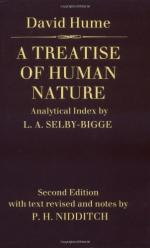First, It has been said against Spinoza, according to the scholastic way of talking, rather than thinking, that a mode, not being any distinct or separate existence, must be the very same with its substance, and consequently the extension of the universe, must be in a manner identifyed with that, simple, uncompounded essence, in which the universe is supposed to inhere. But this, it may be pretended, is utterly impossible and inconceivable unless the indivisible substance expand itself, so as to correspond to the extension, or the extension contract itself, so as to answer to the indivisible substance. This argument seems just, as far as we can understand it; and it is plain nothing is required, but a change in the terms, to apply the same argument to our extended perceptions, and the simple essence of the soul; the ideas of objects and perceptions being in every respect the same, only attended with the supposition of a difference, that is unknown and incomprehensible.
Secondly, It has been said, that we have no idea of substance, which is not applicable to matter; nor any idea of a distinct substance, which is not applicable to every distinct portion of matter. Matter, therefore, is not a mode but a substance, and each part of matter is not a distinct mode, but a distinct substance. I have already proved, that we have no perfect idea of substance; but that taking it for something, that can exist by itself, it is evident every perception is a substance, and every distinct part of a perception a distinct substance: And consequently the one hypothesis labours under the same difficulties in this respect with the other.
Thirdly, It has been objected to the system of one simple substance in the universe, that this substance being the support or substratum of every thing, must at the very same instant be modifyed into forms, which are contrary and incompatible. The round and square figures are incompatible in the same substance at the same time. How then is it possible, that the same substance can at once be modifyed into that square table, and into this round one? I ask the same question concerning the impressions of these tables; and find that the answer is no more satisfactory in one case than in the other.
It appears, then, that to whatever side we turn, the same difficulties follow us, and that we cannot advance one step towards the establishing the simplicity and immateriality o the soul, without preparing the way for a dangerous and irrecoverable atheism. It is the same case, if instead o calling thought a modification of the soul, we should give it the more antient, and yet more modish name of an action. By an action we mean much the same thing, as what is commonly called an abstract mode; that is, something, which, properly speaking, is neither distinguishable, nor separable from its substance, and is only conceived by a distinction of reason, or an abstraction. But nothing is gained by this change of the term of modification, for that of action; nor do we free ourselves from one single difficulty by its means; as will appear from the two following reflexions.




